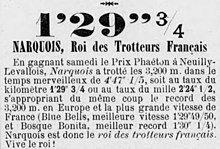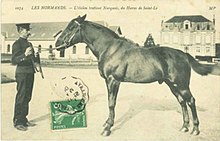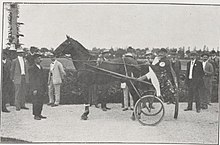Narquois (racehorse)
[5][6] In April 1894, the Grand Prix d'Essai, the traditional first classic of each generation, seemed destined for Neuilly, another son of Fuschia.
[10] In July, Narquois clocked the fastest time for a three-year-old colt over 4,000 meters at Vincennes, 1' 36'' 1/10,[3] in the Critérium des 3 ans ridden trotting race.
[11] He frequently ran with his half-sister Nitouche, from the same stable and sire, who was "sacrificed" to him, but the latter was initially considered better than him.
[14][15] Alban d'Hauthuille, in his study Les courses de chevaux published in 1982 in the PUF Que sais-je?
[4] Later in the season, Narquois raced at Saint-Lô, where he broke the French record over 4,000 meters at mounted trotting, beating Messagère in 6' 16'' 2/5.
[4] Narquois's reputation was excellent at the time, so much so that his defeat the following day at the Cabourg racecourse after a poor start against Novice, Marin and Messagère came as a nasty surprise, suggesting overwork.
[4] Narquois made up for it in his next race at Lisieux, winning the Prix de Quatre Ans against Nymphe, Niemen and Nitouche.
[4] Four days later, Narquois returned to Levallois and beat his own record over 4,200 meters, in 6' 21'', a speed never before achieved over this distance in mounted trotting.
[4] Narquois having beaten all the trotters of his generation, a match was proposed against the mare Ergoline, whose last race was the Prix Zéthus.
[4] He ended his season on 7 October in the Prix de la Marne at Vincennes, which he won easily in 1' 37", ahead of all the other 4-year-old trotters.
[22][23][24] His success as a stallion proved so great that special conditions of access to covering had to be established: only mares with a mileage reduction of 1' 42" were authorized to receive Narquois.
[28] Narquois became less sought-after over time, with 159 registrations in 1908 for a covering at the haras national de Saint-Lô, compared with 177 in 1907.
[35] Breeder Maurice de Gasté described a "deformity" in trotting stallions such as Narquois, which makes them unsuitable for the saddle: the shoulder is straight, short and forward; the neck is high, long underneath, short above, and extremely powerful; the head attachment is thick, with developed maxillae and a strong head; the rump is powerful and strongly sloping.
[42] The Miss Bell mare is, however, described as English (probably largely Thoroughbred) by Nicard, who regrets that her origins are unknown.
[33] The Thoroughbred mare Débutante, dam of Bank Note, seemed to have had a positive influence on her entire lineage.
[47] According to Louis Baume, in 1913, Narquois' foals sold, on average, for between 2,500 and 4,000 francs, as much as Harley's, but less than Fuschia's.
[49] In 1902, when A. Ollivier drew up his Généalogies chevalines anglo-normandes en ligne mâle, he placed Narquois in the Conquérant branch, in the lineage of the English stallion Young Rattler.



